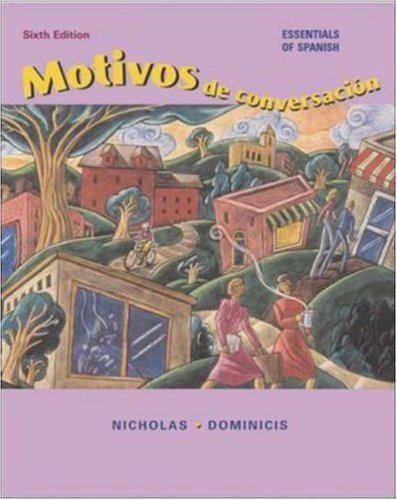Items related to Motivos de conversación with Listening Comprehension...

"synopsis" may belong to another edition of this title.
1. Gráficos: The first part of each lesson opens a section of illustrations, brief dialogues, or narratives that give students early opportunities to express themselves while introducing the chapter vocabulary. Motivos culturales, or culture notes, in this section offer glimpses into everyday customs of the Hispanic world.
2. Gramática esencial: The second part of each lesson is exactly what the name implies the essential grammar. Only the structures necessary for a first-year program are included. Each lesson presents three to six grammar points in a succinct format, followed by practice exercises. A culminating activity, Para resumir y repasar, concludes this part of the lesson and synthesizes all the material presented in the first 2 parts. This unique feature allows instructors to stop after the Para resumir y repasar section, knowing that they have covered all of the active vocabulary and essential grammar for the lesson.
3. Comunicación: This final part of each lesson offers additional communicative practice to enrich and reinforce the material presented in the first 2 parts of the lesson. A new realia-based feature kicks off this section, illustrating the grammar and vocabulary in context, and activities called Para conversar más provide opportunities for pair and group work.
Motivos de conversación can be easily adapted to any beginning course, whether it meets three, four, or five days a week. Because the active vocabulary list for each lesson only includes the terms introduced in the first 2 parts of the lesson, courses meeting three days a week can omit the final part of the lesson, Comunicación, to concentrate on Gráficos and Gramática esencial. Those courses fortunate enough to have 4 or 5 contact hours per week can include the Comunicación section for additional practice and supplemental vocabulary.
After every third lesson, Motivos de conversación includes a useful section called Ampliaciones, which allows students to review the preceding chapters and assess their progress. Each Ampliaciones includes a Lectura, or reading, with reading strategies and comprehension questions; Repasos visuales, or illustrated reviews; and Exámenes de repaso, or self-tests, with answers in Appendix 4 for student self-correction.
Frequent study hints called Memoprácticas are found throughout the text and offer students suggestions on how to study, memorize, and create their own learning aids.
Motivos de conversación, Fourth edition has been shortened to 15 chapters by eliminating some grammar points and consolidating several others. The new structure makes syllabus planning easy whether the text is covered over 2 semesters or 3 quarters.
The grammar sequence has been slightly reorganized with preterite now presented in Lesson 5 and imperfect in Lesson 7, allowing semester schools to introduce both in the first term. The other changes to the grammar sequence can be seen in the Table of Contents.
Two chapter themes have been modified to emphasize the heritage of Spanish-speaking peoples in the New World in general, and in the U.S. in particular. Chapter 7 is now entitled Las Américas: pasado y futuro and Chapter 10 is La presencia hispánica en los Estados Unidos. Some of the interesting new topics introduced for comprehension and discussion in these chapters include NAFTA; political, physical, and psychological ôborders;ö discrimination; pollution; and unemployment.
Many of the dialogues and cultural notes have been revised or rewritten to be more current and to control the vocabulary more carefully. Numerous new drawings reinforce the vocabulary and enliven the text.
The practice material has been updated in the Fourth edition of Motivos de conversaci"n. A context is established for virtually all of the activities and exercises, making the practice material more relevant and more interesting for the student. More pair and group activities have been added to this edition, along with a number of exercises designed to make such interactive activities as role-plays, surveys, interviews, and mini-dialogues easy to introduce in class.
A new chapter-ending cultural spread called Viaje por el mundo hispánico highlights essential facts and interesting features for the major Spanish-speaking countries. A variety of short readings are illustrated by beautiful color photos of key cultural and historical events.
The final part of each lesson, Comunicaci"n, begins with a new realia-based activity called De la vida real. The authentic materials used in this feature come from many different Spanish-speaking countries and present students with glimpses into everyday life in the Hispanic world. De la vida real encourages students to read the material both for the gist as well as for specific information, and concludes with creative, interactive activities based on the realia.
All of the readings in the five Ampliaciones (reduced from six in the previous edition) are authentic Spanish-language articles from popular newspapers or magazines. Four of the Ampliaciones sections contain new readings and the Antes de leer pre-reading sections have been refined to provide students with various hints and reading strategies.
"About this title" may belong to another edition of this title.
- PublisherMcGraw-Hill Higher Education
- Publication date2002
- ISBN 10 0072843314
- ISBN 13 9780072843316
- BindingHardcover
- Edition number6
- Number of pages480
- Rating
(No Available Copies)
Search Books: Create a WantIf you know the book but cannot find it on AbeBooks, we can automatically search for it on your behalf as new inventory is added. If it is added to AbeBooks by one of our member booksellers, we will notify you!
Create a Want